Duchy of Saxe-Altenburg
Herzogtum Sachsen-Altenburg
The
Duchy of Saxe-Altenburg (German: Sachsen-Altenburg) was one of the Saxon duchies held by the Ernestine branch of the Wettin
dynasty in present-day Thuringia. The duchy originated from the medieval Burgraviate of Altenburg in the Imperial Pleissnerland
(Terra Plisensis), a possession of the Wettin Margraves of Meissen since 1243. Upon a partition treaty of 1485, Altenburg
fell to Elector Ernest of Saxony, the progenitor of the Ernestine Wettins. After the Division of Erfurt in 1572 among Duke
John William of Saxony and his nephews, Altenburg fell to his Duchy of Saxe-Weimar.
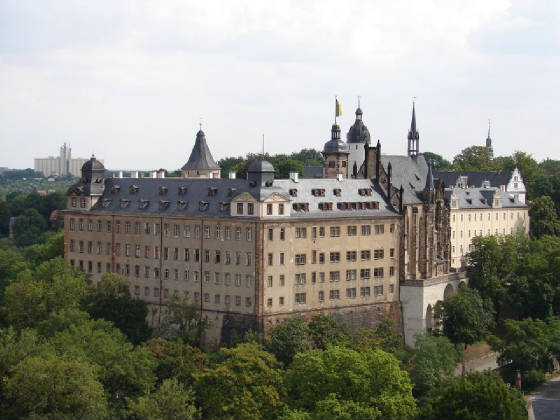
When
in 1602 John William's son and successor Frederick William I died, the Duchy of Saxe-Weimar passed to his younger brother
John II, while in 1603 Frederick William's eldest son John Philip in compensation received the newly created Duchy of Saxe-Altenburg.
It was an Imperial State in its own right, with a vote in the Reichstag, for much of the 17th century until the extinction
of its ruling line in 1672, when it was inherited by Ernest I the Pious, the Duke of Saxe-Gotha, who had married the heiress.
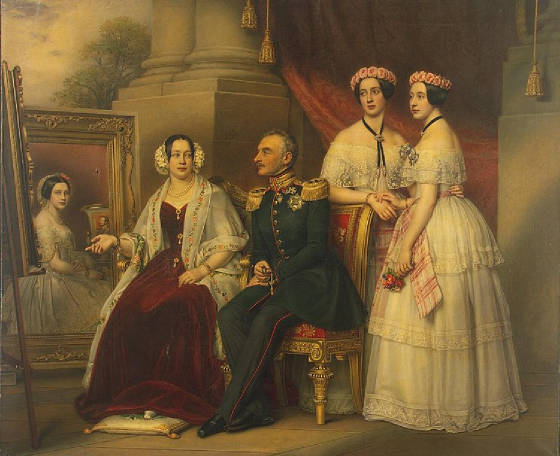
Saxe-Altenburg
thereafter remained part of Saxe-Gotha-Altenburg until the extinction of that house in 1825, when Gotha and Altenburg were
split up, with Gotha going to the Duke of Saxe-Coburg-Saalfeld and Altenburg to the Duke of Saxe-Hildburghausen, who in exchange
gave up Hildburghausen to the Duke of Saxe-Meiningen. This family ruled in the duchy until the end of the monarchies in the
course of the German Revolution of 1918-1919. The succeeding Free State of Saxe-Altenburg was incorporated into the new state
of Thuringia in 1920. Saxe-Altenburg had an area of 1,323 km² and a population of 207,000 (1905). Its capital was
Altenburg. The Saxe-Altenburg line became extinct following the death of Prince George Moritz in 1991.
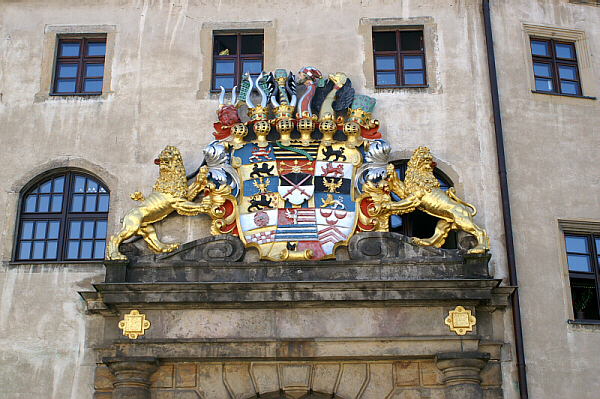
The History of
the House of Wettin
The House of Wettin is a dynasty of German counts, dukes, prince-electors (Kurfürsten)
and kings that once ruled the area of today's German states of Saxony, the Saxon part of Saxony-Anhalt, and Thuringia for
more than 800 years as well as holding at times the kingship of Poland. Agnates of the House of Wettin have, at various times,
ascended the thrones of Great Britain, Portugal, Bulgaria, Poland, Saxony, and Belgium; of these, only the British and Belgian
lines retain their thrones today. The oldest member of the House of Wettin who is known for certain was Thiedericus (died
982), who was probably based in the Liesgau (located at the western edge of the Harz). Around 1000, as part of the German
conquest of Slavic territory, the family acquired Wettin Castle, after which they named themselves.

Wettin Castle is located
in Wettin in the Hosgau on the Saale River. Around 1030, the Wettin family received the Eastern March as a fief. The prominence
of the Wettin family in the Slavic marches caused Emperor Henry IV to invest them with the March of Meissen as a fief in 1089.
The family advanced over the course of the Middle Ages: in 1263 they inherited the landgraviate of Thuringia (though without
Hesse), and in 1423 they were invested with the Duchy of Saxony, centred at Wittenberg,thus becoming one of the prince-electors
of the Holy Roman Empire. The family divided into two ruling branches in 1485 when the sons of Frederick II, Elector of Saxony
divided the territories hitherto ruled jointly. The elder son Ernest, who had succeeded his father as Prince-elector, received
the territories assigned to the Elector (Electoral Saxony) and Thuringia, while his younger brother Albert obtained the March
of Meissen, which he ruled from Dresden. As Albert ruled under the title of "Duke of Saxony", his possessions were
also known as Ducal Saxony.
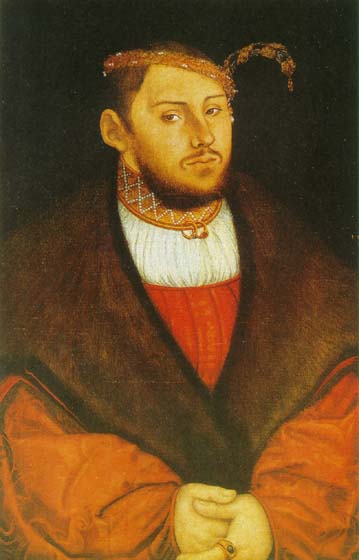
The older, Ernestine branch
remained predominant until 1547 and played an important role in the beginnings of the Protestant Reformation. Their predominance
ended in the Schmalkaldic War, which pitted the Protestant Schmalkaldic League against Emperor Charles V. Although itself
Protestant, the Albertine branch rallied to the Empire's cause; Charles V rewarded them by forcing the Ernestines to sign
away their rights to the Electoral title and lands to the Albertines. The Ernestine line was thereafter restricted to Thuringia,
and its dynastic unity swiftly crumbled. The Albertine Wettin maintained most of the territorial integrity of Saxony, preserving
it as a significant power in the region, and using small appanage fiefs for their cadet branches, few of which survived for
significant lengths of time. The Ernestine Wettin, on the other hand, repeatedly subdivided their territory, creating an intricate
patchwork of small duchies and counties in Thuringia.
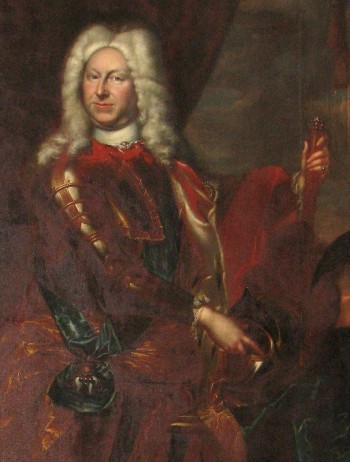
The junior Albertine branch
ruled as Electors (1547-1806) and Kings of Saxony (1806-1918) and also played a role in Polish history: two Wettin were Kings
of Poland (between 1697-1763) and a third ruled the Duchy of Warsaw (1807-1814) as a satellite of Napoleon. After the Napoleonic
Wars, the Albertine branch lost about 40% of its lands, including the old Electoral Saxony, to Prussia, restricting it to
a territory coextensive with the modern Saxony.
The Dukes of Saxe-Altenburg
Elder line
- John Philip,
Duke of Saxe-Altenburg (1603-1639)
- Frederick
William II, Duke of Saxe-Altenburg (1639-1669)
- Frederick
William III, Duke of Saxe-Altenburg (1669-1672)
Line
extinct, inherited by Saxe-Gotha, thereupon Saxe-Gotha-Altenburg
Junior line
- Frederick, Duke of Saxe-Altenburg (1826-1834) (Previously
Duke of Saxe-Hildburghausen)
- Joseph, Duke
of Saxe-Altenburg (1834-1848)
- Georg, Duke of
Saxe-Altenburg (1848-1853)
- Ernst I, Duke of Saxe-Altenburg (1853-1908)
- Ernst II, Duke of Saxe-Altenburg (1908-1918)
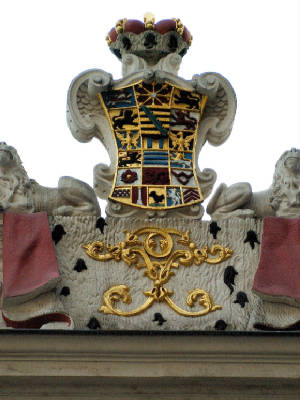
Heads of the Ducal House of Saxe-Altenburg
- Ernst II, Duke of Saxe-Altenburg (1918-1955)
- Georg Moritz, Hereditary Prince of Saxe-Altenburg (1955-1991)
In 1991 the Saxe-Altenburg line became extinct. Its representation
was merged with the one of Saxe-Weimar-Eisenach. Two branches descend from duke Ernest the Pious, the father of
the progenitor of this Saxe-Altenburg branch: Saxe-Meiningen and Saxe-Coburg and Gotha; according to old Wettin
family law, they would have divided the actual territories between them (as happened to Gotha and Altenburg in 1826).

The Family Titles and Styles
The members of this family
bear the title Prince or Princess of Saxe-Altenburg, Duke or Duchess of Saxony together with the formal appellation of His
or Her Highness.
The Genealogy of the Ducal House
FRIEDRICH,
Duke of Saxe-Hildburghausen 23 Sep 1780, became Duke of Saxe-Altenburg 12 Nov 1826 during the redistribution of the family
territories (Hildburghausen 29 Apr 1763-Jagdhaus Hummelshain, nr Altenburg 29 Sep 1834); m.Hildburghausen 3 Sep 1785 Charlotte
Dss of Mecklenburg-Strelitz (Hannover 17 Nov 1769-Hildburghausen 14 May 1818)
1a) Joseph Georg Karl
Friedrich (Hildburghausen 12 Jun 1786-Hildburghausen 30 Jul 1786)
2a) Katharina Charlotte Georgine Friederike
Sophie Therese (Hildburghausen 17 Jun 1787-Bamberg 12 Dec 1847); m.Ludwigsburg 28 Sep 1805 Paul Pr of Württemberg (St.Petersburg
19 Jan 1785-Paris 16 Apr 1852)
3a) Charlotte Auguste (b.and d.Hildburghausen 29 Jul 1788)
4a)
JOSEPH Georg Friedrich Ernst Karl, Duke of Saxe-Altenburg (Hildburghausen 27 Aug 1789-Altenburg 25 Nov 1868); m.Kirchheim
24 Apr 1817 Amalie Dss of Württemberg (Wallisfurth 28 Jun 1799-Altenburg 28 Nov 1848)
1b) Alexandrine Marie Wilhelmine Katharine Charlotte Therese Henriette Luise Pauline Elisabeth Friederike Georgine
(Hildburghausen 14 Apr 1818-Gmunden 9 Jan 1907); m.Hannover 18 Feb 1843 King Georg V of Hannover (Berlin 27 May 1819-Paris
12 Jun 1878)
2b) Pauline Friederike Henriette Auguste (Kirchheim unter Teck 24 Nov 1819-Hildburghausen 11 Jan
1825)
3b) Henriette Friederike Therese Elisabeth (Hildburghausen 9 Oct 1823-Altenburg 3 Apr 1915)
4b) Elisabeth Pauline Alexandrine (Hildburghausen 26 Mar 1826-Oldenburg 2 Feb 1896); m.Hildburghausen 10 Feb 1852
Peter II, Grand Duke of Oldenburg (Oldenburg 8 Jul 1827-Rastede 13 Jun 1900)
5b)
Alexandra Friederike Henriette Pauline Marianne Elisabeth (Altenburg 8 Jul 1830-St.Petersburg 6 Jul 1911); m.St.Petersburg
11 Sep 1848 Constantine, Grand Duke of Russia (St.Petersburg 21 Sep 1827-Pavlovsk 25 Jan 1892)
6b) Luise (Altenburg
4 Jun 1832-Hummelshain 29 Aug 1833)
5a) Luise Friederike Marie Karoline Auguste Christiane (Hildburghausen 18
Jan 1791-Hildburghausen 25 Mar 1791)
6a) Therese Charlotte Luise Friederike Amalie (Hildburghausen 8 Jul 1792-Munich 26 Oct 1854); m.Munich 12 Oct 1810
King Ludwig I of Bavaria (Strassburg 25 Aug 1786-Nice 29 Feb 1868)
7a) Charlotte Luise Friederike Amalie Alexandrine
(Hildburghausen 28 Jan 1794-Biebrich 6 Apr 1825); m.Weilburg 24 Jun 1814 Wilhelm, Duke of Nassau-Weilburg (Kirchheimbolanden
14 Jun 1792-Kissingen 20 Aug 1839)
8a) Franz Friedrich Karl Ludwig Georg Heinrich (Hildburghausen 13 Apr 1795-Hildburghausen
28 May 1800)
9a) GEORG Karl Friedrich, Duke of Saxe-Altenburg (Hildburghausen 24 Jul 1796-Hummelshain 3 Aug 1853); m.Ludwigslust
7 Oct 1825 Maria Dss of Mecklenburg-Schwerin (Ludwigslust 31 Mar 1803-Meiningen 26 Oct 1862)
1b) ERNST I Friedrich Paul Georg Nikolaus, Duke of Saxe-Altenburg (Hildburghausen 16 Sep 1826-Altenburg 7 Feb 1908);
m.Dessau 28 Apr 1853 Agnes Pss of Anhalt-Dessau (Dessau 24 Jun 1824-Hummelshain 23 Oct 1897)
1c)
Marie Friederike Leopoldine Georgine Auguste Alexandra Elisabeth Therese Josephine Helene Sophie (Eisenberg 2 Aug 1854-Camenz
8 Oct 1898); m.Berlin 19 Apr 1873 Albrecht Pr of Prussia (Berlin 8 May 1837-Camenz 13 Sep 1906)
2c) Georg Leopold
Ernst Joseph Alexander Friedrich Ludwig Johann Albert (Altenburg 1 Feb 1856-Altenburg 29 Feb 1856)
2b) Albrecht Friedrich August Bernhard Ludwig
Anton Carl Gustav Eduard (Hildburghausen 31 Oct 1827-Ludwigslust 28 May 1835)
3b)
Moritz Franz Friedrich Constantin Alexander Heinrich August Carl Albrecht (Eisenberg 24 Oct 1829-Arco, Italy 13 May 1907);
m.Meiningen 15 Oct 1862 Auguste Pss of Saxe-Meiningen (Meiningen 6 Aug 1843-Altenburg 11 Nov 1919)
1c)
Marie Anne (Altenburg 14 Mar 1864-Bückeburg 3 May 1918); m.Altenburg 16 Apr 1882 Georg Pr zu Schaumburg-Lippe (Bückeburg
10 Oct 1846-Bückeburg 29 Apr 1911)
2c) Elisabeth Auguste Marie Agnes (Meiningen 25 Jan 1865-Leipzig 24 Mar 1927); m.St.Petersburg 27 Apr 1884 Constantine,
Grand Duke of Russia (Strelna 22 Aug 1858-Pavlovsk 15 Jun 1915)
3c) Margarete Marie Agnes Adelheid Karoline Friederike
(Altenburg 22 May 1867-Altenburg 17 Jun 1882)
4c) ERNST II Bernhard Georg Johann Karl Friedrich Peter Albert, abdicated 13 Nov 1918 (Altenburg 31 Aug 1871-Schloß
Fröhliche Wiederkunft 22 Mar 1955); m.1st Bückeburg 27 Feb 1898 (div 1920) Adelheid Pss zu Schaumburg-Lippe (Ratiboritz
22 Sep 1875-Ballenstedt 27 Jan 1971); m.2d Schloß Fröhliche Wiederkunft 15 Jul 1934 Maria Triebel "Freifrau
von Rieseneck" (Waltershausen, Thuringia 16 Oct 1893-Wolfersdorf 28 Feb 1955)
1d) Charlotte Agnes Ernestine Auguste Bathildis Marie Therese Adolfine (Potsdam 4 Mar 1899-Hemmelmark bei Eckernförde
16 Feb 1989); m.Hemmelmark 11 Jul 1919 Sigismund Pr of Prussia (Kiel 27 Nov 1896-Puntarenas, Costa Rica 14 Nov 1978)
2d)
Wilhelm GEORG MORITZ Ernst Albert Friedrich Karl Konstantin Eduard Max, Hereditary Pr of Saxe-Altenburg (Potsdam 13 May 1900-Rendsburg
13 Feb 1991)
3d) Elisabeth Karola Viktoria Adelheid Hilda Luise Alexandra (Potsdam 6 Apr 1903-Breiholz 30 Jan
1991)
4d) Friedrich Ernst Karl August Albert (Potsdam 15 May 1905-Rosenheim 23 Feb 1985)
5c) Luise Charlotte Marie Agnes (Altenburg 11 Aug 1873-Altenburg 14 Apr 1953); m.Altenburg 6 Feb 1895 (div 1918)
Eduard, Duke of Anhalt (Dessau 18 Apr 1861-Berchtesgaden 13 Sep 1918)
10a) Friedrich Wilhelm Karl Joseph Ludwig Georg (Hildburghausen 4 Oct 1801-Altenburg
1 Jul 1870)
11a) Maximilian Karl Adolf Heinrich (Hildburghausen 19 Feb 1803-Hildburghausen 29 Mar 1803)
12a) Eduard Karl Wilhelm Christian (Hildburghausen 3 Jul 1804-Munich 16 May 1852); m.1st Sigmaringen 25 Jul 1835 Amalie
Pss von Hohenzollern-Sigmaringen (Sigmaringen 30 Apr 1815-Sigmaringen 14 Jan 1841); m.2d Greiz 8 Mar 1842 Luise Pss Reuss
(Greiz 3 Dec 1822-Ernstbrunn 28 May 1875)
1b)
Therese Amalie Karoline Josephine Antoinette (Ansbach 21 Dec 1836-Stockholm 9 Nov 1914); m.Altenburg 16 Apr 1864 August Pr
of Sweden (Drottningholm 24 Aug 1831-Stockholm 4 Mar 1873)
2b) Antoinette Charlotte Marie Josephine Karoline Frida (Bamberg 17 Apr 1838-Berchtesgaden 13 Oct 1908); m.Altenburg
22 Apr 1854 Friedrich I, Duke of Anhalt (Dessau 29 Apr 1831-Ballenstedt 24 Jan 1904)
3b) Ludwig Joseph Karl Georg
Friedrich (Bamberg 24 Sep 1839-Munich 13 Feb 1844)
4b) Johann Friedrich Joseph Karl (Sigmaringen 8 Jan 1841-Munich
25 Feb 1844)
5b) Albert Heinrich Joseph Carl Viktor Georg Friedrich (Munich 14 Apr 1843-Serrahn 22 May 1902); m.1st Berlin 6 May
1885 Marie Pss of Prussia (Potsdam 14 Sep 1855-Albrechtsberg 20 Jun 1888) ; m.2d Remplin 13 Dec 1891 Helene Dss of Mecklenburg
(St.Petersburg 16 Jan 1857-Remplin 28 Aug 1936)
1c) Olga Elisabeth Carola Victoria Maria Anna Agnes Antoinette (Schloß Albrechtsberg 17 Apr 1886-Münster
13 Jan 1955); m.Reichen 20 May 1913 Carl Friedrich Gf von Pückler-Burghauss Frhr von Groditz (Breslau 7 Oct 1886-Cimelice
13 May 1945)
2c)
Maria (Schloß Albrechtsberg 6 Jun 1888-Hamburg 12 Nov 1947); m.Altenburg 20 Apr 1911 (div 1921) Heinrich XXXV Pr Reuss
(Mauer 1 Aug 1887-Dresden-Loschwitz 17 Jan 1935)
6b) Marie Gasparine Amalie Antoinette Karoline Elisabeth Luise (Munich 28 Jun 1845-Sondershausen 5 Jul 1930); m.Altenburg
12 Jun 1869 Karl Günther Fst von Schwarzburg-Sondershausen (Arnstadt 7 Aug 1830-Weißer Hirsch 28 Mar

